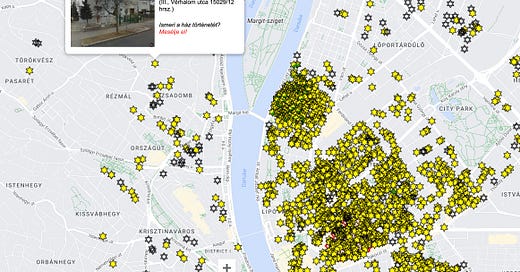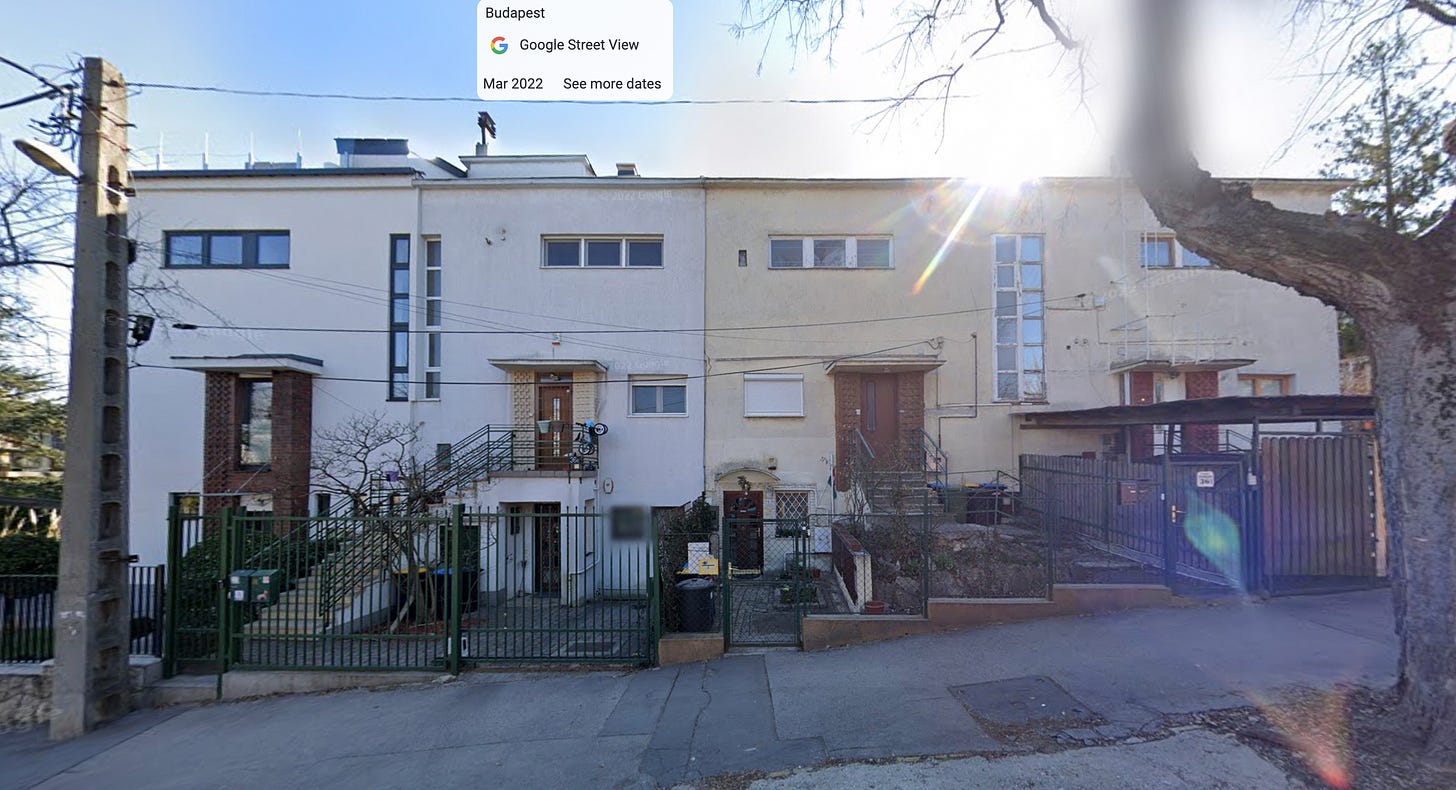One of the unusual aspects of the Holocaust in Hungary — and specifically Budapest — was the creation of yellow-star houses. Instead of setting up fully enclosed ghettos, all Jews in Budapest were forced to move into a yellow-star house on June 21, 1944.
I’ve been wondering what happened to Árpád, Margit, and Matthias during this time. Did they move into a yellow star house? If so, what happened to their home?
Today, I figured it out: I found a website that maps all of the yellow star houses in Budapest during 1944. I searched the yellow-star map using the address Opapa gave to U.S. immigration officials in 1940: III Verhalom Ucca 36/c, Budapest, Hungary.
This address is very similar to the address on Margit Muranyi’s survivor record from 1946, which lists Verhalom 26. This latter record is likely a typo, since if you look at Verhalom 26 on Google maps, there is not much there.
I initially thought that Árpád and Margit’s house may have been demolished, but once I realized that Opapa’s immigration record listed a slightly different address from Margit’s record (Verhalom 36 v. Verhalom 26), I cross-checked both addresses with the map of yellow star houses, and I realized that their house is listed:
So, that’s the answer: they did not move, but rather stayed in their home, which became a yellow-star house. We know from Árpád’s letters from 1940 and 41 that they had already started renting out some of the house, since Árpád was not able to work. In 1944, they would have been forced to move into just one room, while another family (or families) may have been assigned to move in with them.
In addition to answering the question about where Árpád and Margit lived, the visualization of the yellow-star houses offers some insights that aren’t as readily obvious from textual records:
First of all, you can see how many Jews lived in Budapest. We know the numbers: according to the yellow star website, 220,000 Jews and converted Jews were forced to move into 1,944 yellow star houses and apartments. It’s one thing to read the numbers, but it’s another to see how the yellow star houses overwhelm the city center of Budapest. In 1941, the population of Budapest was roughly 1.1 million, which means that about one in five people was identified as a Jew: that is a lot. This was no tiny minority: it was twenty percent of the city’s population.
Second, you can see where many of the Jews were concentrated: in the city center of Pest. The Gerbner household, meanwhile, was relatively isolated away from the majority of the Jewish population in Buda. I think this speaks, in part, to the fact that Árpád was assimilated — one of the many Jews of Budapest who identified more as a Hungarian (and a communist) than as a Jew, and he was not (as far as I know) an active part of any Jewish congregation.
In the block of four houses on Verhálom utca, I think that Árpad and Margit lived in the one second to the right, 36/c. Here is the image from Google street view, taken in March 2022:
Again, the visual image offers new types of information. The houses themselves must have been pretty new in the 1930s: they look like modernist constructions (maybe Dad will have more insight here?).
Of the block of four houses, theirs was the only yellow-star house. This makes me wonder about their neighbors. For years, they had lived side-by-side. Presumably, they all knew each other. What did the residents of Verhálom 36/b and Verhálom 36/d think about what was happening? Did they offer reassurance or support? Did they retreat from the Gerbner household, fearing that the emblem of the yellow star would endanger them as well? Were they, perhaps, part of the large subset of the Hungarian population that harbored deeply-held anti-Semitic beliefs? Or did they simply not care, and go about their daily business?
We don’t know, but seeing the image of the four houses tightly packed together reminds me of Hannah Arendt’s quotation that “evil thrives on apathy and cannot survive without it.”






Real interesting! I have been to that house, visiting Margit and her husband at the time in the early 70's. I remember it well, especially the street being at a steep incline going up from the Danube.
I would say the house is in the Bauhaus style, probably built in the late 20's or early to mid 30's. I know Opapa lived in an apartment building in Pest (he showed it to us) where Margit had a business going when they lived there, so they must have moved to Buda in the mid to late 30's. .... that being said, if you discover otherwise let me know. Obviously there is a lot in my family's history that I didn't know!
I doubt I would ever find pictures I took, if I did take any; not sure anymore where to look.
I'll try.